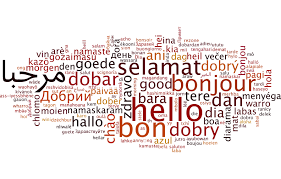The Power of Language: Connecting Minds and Cultures
Language is more than just a means of communication; it is a powerful tool that shapes our thoughts, emotions, and interactions with the world around us. From the melodic tones of Italian to the intricate characters of Mandarin, each language carries its own unique beauty and cultural significance.
At its core, language serves as a bridge that connects individuals from different backgrounds and allows for the exchange of ideas, stories, and traditions. Through language, we are able to express our deepest thoughts, share our experiences, and build connections with others on a profound level.
Language not only facilitates communication but also plays a crucial role in shaping our identities. The words we use reflect our values, beliefs, and worldview, influencing how we perceive ourselves and others. Through language, we are able to preserve our heritage, pass down traditions to future generations, and celebrate the diversity that enriches our societies.
Moreover, language has the power to break down barriers and foster understanding between people from different cultures. By learning a new language, we gain insight into the customs, history, and perspectives of others, fostering empathy and promoting cross-cultural dialogue.
In today’s interconnected world, multilingualism is more valuable than ever. Speaking multiple languages not only enhances cognitive abilities but also opens up new opportunities for personal growth and professional development. Whether for travel, work or personal enrichment, learning a new language can broaden horizons and enrich lives in countless ways.
As we navigate the complexities of an increasingly globalised world, let us embrace the power of language as a force for unity and understanding. Let us celebrate the richness of linguistic diversity that unites us all as members of the human family.
Understanding Language: Definitions, Types, and Importance
- What are 12 languages?
- What do we mean by language?
- What is the definition of a language?
- What is your definition of language?
- What is language and why is it important?
- What are the 7 types of language?
What are 12 languages?
The question “What are 12 languages?” often arises when people are curious about the diversity of languages spoken around the world. There are thousands of languages spoken globally, with some estimates suggesting around 7,000 different languages in existence. From widely spoken languages such as English, Spanish, and Mandarin to lesser-known ones like Navajo, Icelandic, or Swahili, the linguistic tapestry of our world is vast and varied. Exploring different languages not only opens doors to new cultures and perspectives but also highlights the richness of human expression through diverse linguistic traditions.
What do we mean by language?
Language is a complex and multifaceted system of communication that encompasses spoken, written, and gestural forms of expression. It goes beyond mere words and grammar, serving as a fundamental tool for conveying thoughts, emotions, and ideas. Language not only enables us to interact with others but also shapes our perceptions of the world and influences our cultural identities. It is a dynamic and ever-evolving aspect of human society that plays a crucial role in connecting individuals, preserving traditions, and fostering understanding across diverse communities.
What is the definition of a language?
The definition of a language encompasses more than just a set of words and grammar rules; it is a complex system of communication that reflects the culture, history, and identity of a community. A language serves as a medium through which individuals express their thoughts, emotions, and experiences, enabling meaningful interactions and connections with others. Beyond mere words, language embodies the essence of human expression, creativity, and diversity, shaping the way we perceive the world and communicate our ideas.
What is your definition of language?
Language is a complex and dynamic system of communication that encompasses spoken, written, and signed forms of expression. It serves as a fundamental tool for conveying thoughts, emotions, and ideas between individuals, enabling us to connect, share knowledge, and build relationships. Language is not merely a set of words and grammar rules but a reflection of culture, identity, and human creativity. It shapes how we perceive the world and influences our interactions with others. In essence, language is the cornerstone of human civilisation, allowing us to express our deepest thoughts and feelings while fostering understanding and connection across diverse societies.
What is language and why is it important?
Language is the cornerstone of human communication, a complex system of symbols and sounds that allows us to express thoughts, emotions, and ideas. Beyond mere words, language serves as a powerful tool for connecting individuals, preserving culture, and fostering understanding between diverse communities. It shapes our identities, influences how we perceive the world, and enables us to share our stories across generations. Language is not just a means of communication; it is a fundamental part of what makes us human, essential for building relationships, exchanging knowledge, and bridging cultural divides. Its importance lies in its ability to transcend barriers and unite people in a shared experience of expression and connection.
What are the 7 types of language?
In linguistics, the classification of languages is a complex and dynamic field that goes beyond a simple enumeration of seven distinct types. While there isn’t a universally accepted list of “7 types of language,” scholars often categorise languages based on various criteria such as syntax, morphology, phonology, semantics, and pragmatics. Some common language classifications include isolating languages, agglutinative languages, fusional languages, polysynthetic languages, analytic languages, synthetic languages, and tonal languages. Each type exhibits unique features and structures that contribute to the rich diversity of human communication systems across the globe.



